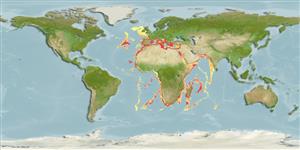Common names from other countries
Environment: milieu / climate zone / depth range / distribution range
экология
; пределы глубины 80 - 3300 m (Ref. 127635), usually 350 - 800 m (Ref. 80214). Tropical, preferred 19°C (Ref. 107945); 49°N - 30°S, 41°W - 75°E
Eastern Atlantic, Mediterranean and Western Indian Ocean: from Brazil to France, south to Natal, South Africa and east to Maldives.
Length at first maturity / Size / Вес / Возраст
Maturity: Lm 3.2 range ? - ? cm Max length : 22.0 cm TL самец/пол неопределен; (Ref. 8); 7.1 cm CL (female); наибольший возраст (опубликованны данные): 6 годы (Ref. 80242)
Demersal (Ref. 80214). Maximum length for females from Ref. 80234. Demersal on muddy bottoms of slopes of continental shelf, in zones close to submarine canyons. Moves from depths of 200 m during the night to 800 m during the day, and changes location within the year (Ref. 80214). Feeds on small benthic invertebrates mainly crustaceans and polychaetes and also carrion (Ref. 434).
Members of the order Decapoda are mostly gonochoric. Mating behavior: Precopulatory courtship ritual is common (through olfactory and tactile cues); usually indirect sperm transfer.
Основная ссылка
ссылки | координатор | соавторы
Holthuis, L.B. 1980. (Ref. 8)
Статус Красного Списка МСОП (Ref. 130435)
Статус СИТЕС (Ref. 108899)
Not Evaluated
Not Evaluated
Использование человеком
рыболовство: важный объект промысла
FAO - рыболовство: landings, Видовой профиль | FIRMS (Stock assessments) | FishSource | Sea Around Us
инструменты
дополнительная информация
ресурсы в Интернет
Estimates based on models
Preferred temperature
(Ref.
115969): 6.6 - 18.3, mean 13.3 (based on 351 cells).
устойчивость к внешним воздействиям
высокий, минимальное время удвоения популяции до 15 месяцев (K=0.14-0.99; tmax=6).
Prior r = 0.66, 95% CL = 0.44 - 0.99, Based on 7 full stock assessments.
Уязвимость
Low vulnerability (12 of 100).
